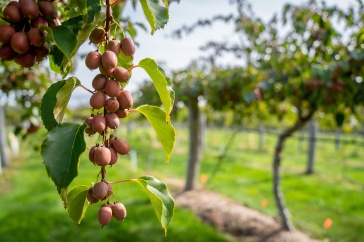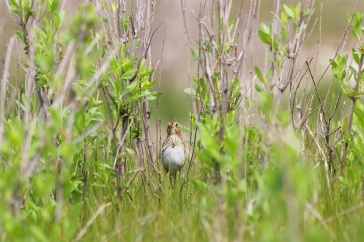
Researchers have planted an orchard of the fast-growing shrub at UNH’s Kingman Farm to determine the life history characteristics of invasive glossy buckthorn under controlled conditions, free from competition with other plants, and free from variation in other environmental factors such as soil or micro-climate.
If Tom Lee was a superhero, glossy buckthorn would be his personal arch nemesis. For decades, the researcher with the NH Agricultural Experiment Station at the University of New Hampshire has been fighting against this invasive shrub that takes aim at some of the state’s most economically important forests such as the eastern white pine.
Now Lee, associate professor of forest ecology, and Steve Eisenhaure, land use coordinator with the UNH Office of Woodlands and Natural Areas, are maneuvering to get the home field advantage with glossy buckthorn – they have planted an orchard of the fast-growing shrub at UNH’s Kingman Farm.

By planting the orchard, the team aims to determine the life history characteristics of invasive glossy buckthorn under controlled conditions, free from competition with other plants, and free from variation in other environmental factors such as soil or micro-climate. They also will test, under rigorously controlled conditions, the effect of competition from glossy buckthorn on seedlings of the eastern white pine and determine the impact of manual cutting of glossy buckthorn of different ages on buckthorn growth and survival.
“We have very little information on the life history characteristics of glossy buckthorn. Life history characteristics include age of first flowering, seasonal time of flowering and fruiting, height and stem diameter growth by year and time of year. This is basic information that we require to better understand and manage the plant. All of our data so far are from field sites where buckthorn is growing with different plant species, on different soils, and where sites have different histories. It’s tough to disentangle all those variables and their effects on buckthorn. The orchard removes a lot of that variation and allows us to observe buckthorn in an unfettered condition,” Lee said.
Glossy buckthorn outcompetes with native plants, including the economically important eastern white pine. According to the North East State Foresters Association, the annual value of sales of New Hampshire’s forest products industry totals nearly $1.4 billion. When a tree canopy of white pines is opened up, such as after logging, glossy buckthorn can take over an area in just a few years, forming a dense thicket.

“While we have studied buckthorn effects on native trees in the field, once again we have to deal with a lot of natural variability. We know that buckthorn inhibits white pine seedlings, but the magnitude of the effect has been difficult to estimate precisely. With the controlled conditions of the orchard, we should be able to make more precise statements about the effects of buckthorn on white pine growth and survival,” Lee said.
There are three main methods to control glossy buckthorn: herbicides, manual cutting, and manual removal. Lee and Eisenhaure have experimented with manually cutting buckthorn to control it. They have found that cutting plants at the base sets them back and liberates the native plants with which they compete. They hypothesize that cutting will be more successful, perhaps even killing buckthorn, if it is applied to young, small buckthorn individuals.
“The orchard gives us a chance to test this hypothesis under tightly controlled circumstances,” Lee said.
Eventually the team plans to examine the role of site preparation on glossy buckthorn invasion – to see if they can inhibit buckthorn invasion by planting mixes of other species such as grass turfs or by compacting soils.
“Control of these creatures is very difficult and very expensive. The key to invasive control is early detection and rapid response. You should know your land, know your forest, know where those invasives are coming in, and get them out of there. If you let them linger, you are toast,” Lee said.
This material is based upon work supported by the NH Agricultural Experiment Station, through joint funding of the National Institute of Food and Agriculture, U.S. Department of Agriculture, under award number 0225004, and the state of New Hampshire.
Founded in 1887, the NH Agricultural Experiment Station at the UNH College of Life Sciences and Agriculture is UNH’s original research center and an elemental component of New Hampshire's land-grant university heritage and mission. We steward federal and state funding, including support from the USDA National Institute of Food and Agriculture, to provide unbiased and objective research concerning diverse aspects of sustainable agriculture and foods, aquaculture, forest management, and related wildlife, natural resources and rural community topics. We maintain the Woodman and Kingman agronomy and horticultural farms, the Macfarlane Greenhouses, the Fairchild Dairy Teaching and Research Center, and the Organic Dairy Research Farm. Additional properties also provide forage, forests and woodlands in direct support to research, teaching, and outreach.
-
Written By:
Lori Tyler Gula, PhD | NH Agricultural Experiment Station | lori.gula@unh.edu | 603-862-1452
















































